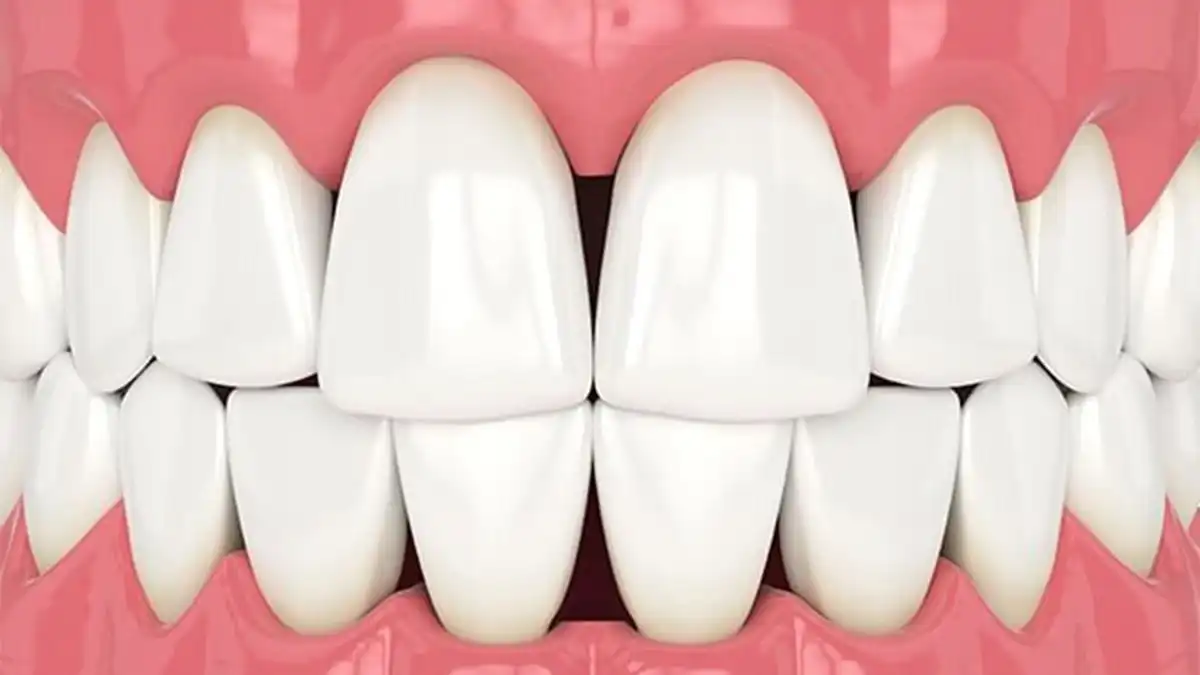What Are The Black Triangles’ Between Your Teeth?


If you’ve ever had your picture taken and then saw what looked like black triangles on teeth throughout your mouth, they’re actually small teeth gaps next to your gumlines. What are the black triangles on teeth caused by? Usually, it’s because of gum recession of some type, or even having misaligned and crooked teeth. Issues like gum disease and tartar buildup are also big factors. The best way to avoid or even treat black triangles on teeth is to have a good understanding of what causes them in the first place.
What Causes Black Triangles On Teeth?
There are five main reasons behind black triangles on teeth and small teeth gaps between your teeth next to the gums. Ultimately what you’re seeing in that space is a shadow. It’s caused by the empty space from your gum’s “papilla” pulling away. The papilla is the sharp, pointy part of gum tissue that extends between each tooth. Any time the papilla is damaged, diseased, or pulled away, it leaves a void. In turn, you see that empty space and the dark shadow that goes along with it.
1. Gum Recession
Treatment
Gum recession treatment will usually involve a soft tissue graft, Pinhole treatment, or hyaluronic acid (similar to what you see in dermal fillers.) The sooner you treat receding gums, the better chances you have of saving your tooth and supporting bone structure.
2. Poor Dental Hygiene
If you aren’t keeping your gums clean (including just underneath the edges) it’s easy for them to get infected. In turn, they pull away from your tooth. But maybe you are cleaning your gums and flossing each day. If you’re too aggressive, that can cause gum recession too. Harsh brushing or jabbing straight down into your gums with floss (instead of sliding under it) can permanently damage the shape of your gingival tissues.
Treatment
Use a soft or extra-soft toothbrush to clean your gumlines each day. When flossing, wrap the strand around your tooth and gently rub it up and down under the edges. Or consider using a water flosser instead. Make sure you’re scheduling a professional dental cleaning at least every six months to remove any buildup that accumulates in hard-to-reach spaces.
3. Bone Loss
Periodontal disease (gum disease) causes both bone and gum loss. When there’s active bacteria under your gums, the bone naturally starts to resorb or shrink in that location. And any time we lose bone, the gum tissues soon follow. Symptoms include tooth mobility, teeth gaps, and black triangles on teeth.
Treatment
A series of deep cleanings is usually appropriate. Other therapies may include bone grafting, gum grafting, hyaluronic acid treatment, laser therapy, or in more aggressive infections, extractions. Have your dentist measure your bone levels during each checkup so that you know whether they’re healthy or not.
4. Orthodontic Device Or Treatment
Occasionally we can see gum recession caused by aggressive orthodontic therapy or maybe even an appliance rubbing your gums unnaturally. Perhaps the appliance is old and needs to be adjusted (like a mouthguard or retainer) or the teeth are being moved too quickly. That’s why things like “fast braces” or “accelerated orthodontics” may not be appropriate for some people; it can be traumatic to your oral tissues if your teeth are significantly misaligned.
Treatment
If you’re wearing a removable appliance, bring it to your dentist to have it evaluated. If you’re someone who is undergoing rapid orthodontic changes, talk to your dentist or possibly get a second opinion from another provider.
5. Tooth Shape
Teeth come in all shapes and widths. Typically, they’re wider at one area of the crown and then more narrow near the gumlines. And even though each of our teeth are different, they still line up alongside of each other nicely. But if you have an irregular tooth shape (such as a “peg lateral” or something like that) it can automatically cause the gums around it to look misshaped as well.
Treatment
The best treatment for an atypical tooth shape is usually a cosmetic crown or veneer. If the discrepancy is small, bonding may also be an option. Ultimately what you’re trying to do is add some width to the tooth near the gums. But don’t add too much width, or the tooth shape will look bulky and unnatural.
How Can You Fix The Teeth Gaps?

1) Proper Dental Hygiene
Gingivitis, tartar buildup, and periodontal infections are probably the biggest factors when it comes to why some teeth get black triangles. When you’re not cleaning well along your gum tissues, they can easily get infected. And once tartar builds up in that space, your gums will pull back even more.
Ideally, you need to be cleaning your gumlines twice a day and flossing at least once a day. Once plaque calcifies into tartar, it’s there permanently until your hygienist cleans it off. In other words, it’s a constant irritant to your gums.
SIDE NOTE: Proper flossing is just as important. If you’re jerking the floss straight up and down between your teeth, you could be traumatizing your gums so much that they recede. Always curve your floss against the tooth and slide it under the gums.
2) Veneers
Cosmetic porcelain veneers are specifically designed for enhancing the way your teeth look when you smile. So, if your teeth are crooked, slightly gapped, or you notice black triangles along the margins, veneers are worth considering. They require a two-step treatment about two weeks apart. Since veneers only cover the front and just over the edges of teeth, they’re great for hiding moderate to severe aesthetic concerns on otherwise healthy teeth. You can even select how you want them to be shaped and what color you want them to be.
3) Orthodontics
- Braces Traditional are straightforward, efficient, and budget-savvy. They also come in ceramic versions for adults who want a more low-profile experience. The bracket and wire system consecutively guide all of the teeth into the desired arch shape.
- Clear aligners are a bit more attractive for adult patients. Since they’re removable, you can also have an easier go at your oral hygiene habits during treatment. Just take them out to brush and floss. Change the aligners out as directed every two weeks. Each set of trays is digitally programmed to move specific teeth in precise directions.
4) Dental Bonding/Composite Resin
Cosmetic bonding is a quick and easy way to cover up minor tooth discrepancies. There’s usually no drilling or numbing even involved. Your dentist uses a matching resin material to cover and reshape a specific area on your tooth, then cures it with a bright light. Bonding is one of the fastest and most affordable ways to hide black triangles on teeth.
5) Dental Crowns
If your teeth are significantly misshaped, narrow, or the teeth gaps come up well above the normal gumlines, you’ll probably see the best results from a set of crowns. Since crowns cover your entire tooth, your dentist has the ability to adjust more than just one side at a time. Plus, they reinforce teeth that have existing decay or wear, allowing them to serve a dual purpose. But if your tooth is otherwise healthy and intact, a crown may actually be more overkill than what you really need.
6) Hyaluronic Acid Treatment
Cosmetic injectables and fillers can also be used inside of your mouth. In this case, hyaluronic acid can either be applied topically to your gums or injected underneath them. Not only do they help to safely plump up your tissues to add volume, but these products can also help combat the effects of periodontal disease. It can be a one-time treatment or one where you also need to use it at home.
7) Tissue Grafting
Any time the gum tissues are seriously distorted or receded, you want to consider grafting new tissue back into their place. Gums play a crucial role in protecting your tooth and the underlying bone. Without them, you’re more prone to sensitivity and decay (and of course in this case, black triangles on teeth.) Grafting uses tissue taken from a donor site and moves it over your exposed tooth. An alternative to grafting is Pinhole rejuvenation, which is like tugging on the surrounding gum tissue to pull it up and over the receded area.
Preventing Gaps In Teeth?
If you’re worried that perhaps you’re starting to see the early stages of black triangles on teeth, you can prevent them from forming altogether. The key is to see your dentist regularly for exams, talk to your hygienist about the best oral hygiene plan, and to take great care of your gums.
To keep your gums nice and tight around your teeth, flossing is the first step. Healthy gums — without any swelling, bleeding, or buildup around them — stay connected higher up on the tooth than gums that are infected. You need intact gum tissues to avoid getting black triangles on teeth. The sooner you spot signs of recession, the better care you can take to avoid black triangles before they ever start to show up.
Overcoming Black Triangles On Your Teeth
What are the black triangles on teeth? They’re small teeth gaps caused by the papilla (pointed gums) pulling back and leaving a void in that space. They can also be the result of crooked or misaligned teeth. Understanding the cause of black triangles on teeth is the first step in preventing and treating them. Even if you aren’t bothered by the way they look, these small open spaces can put you at a higher risk of tooth decay and bone loss in the future. Preventing them is the best treatment.

Make your inbox smile!
Subscribe






